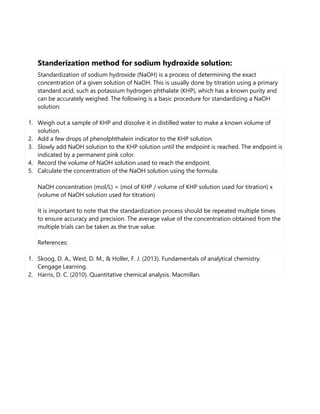standerization.docx
•Download as DOCX, PDF•
0 likes•2 views
Standardization of a sodium hydroxide (NaOH) solution involves titrating it against a standard acid solution of known concentration and purity, such as potassium hydrogen phthalate (KHP). The procedure involves dissolving a weighed sample of KHP in water, adding an indicator and titrating with NaOH until the endpoint is reached. The concentration of NaOH is then calculated using the titrated volumes and mole amount of KHP. The process should be repeated and the average concentration taken for accuracy.
Report
Share
Report
Share

Recommended
Recommended
“Oh GOSH! Reflecting on Hackteria's Collaborative Practices in a Global Do-It...

“Oh GOSH! Reflecting on Hackteria's Collaborative Practices in a Global Do-It...Marc Dusseiller Dusjagr
More Related Content
Similar to standerization.docx
Similar to standerization.docx (20)
Presentation of pharmaceutical analysis on kjeldhal method of nitrogen estima...

Presentation of pharmaceutical analysis on kjeldhal method of nitrogen estima...
NCHE 211 UNIT 2 VOLUMETRY and Complexometry titration.pdf

NCHE 211 UNIT 2 VOLUMETRY and Complexometry titration.pdf
Recently uploaded
“Oh GOSH! Reflecting on Hackteria's Collaborative Practices in a Global Do-It...

“Oh GOSH! Reflecting on Hackteria's Collaborative Practices in a Global Do-It...Marc Dusseiller Dusjagr
Mattingly "AI & Prompt Design: Structured Data, Assistants, & RAG"

Mattingly "AI & Prompt Design: Structured Data, Assistants, & RAG"National Information Standards Organization (NISO)
Recently uploaded (20)
“Oh GOSH! Reflecting on Hackteria's Collaborative Practices in a Global Do-It...

“Oh GOSH! Reflecting on Hackteria's Collaborative Practices in a Global Do-It...
18-04-UA_REPORT_MEDIALITERAСY_INDEX-DM_23-1-final-eng.pdf

18-04-UA_REPORT_MEDIALITERAСY_INDEX-DM_23-1-final-eng.pdf
A Critique of the Proposed National Education Policy Reform

A Critique of the Proposed National Education Policy Reform
Introduction to ArtificiaI Intelligence in Higher Education

Introduction to ArtificiaI Intelligence in Higher Education
Kisan Call Centre - To harness potential of ICT in Agriculture by answer farm...

Kisan Call Centre - To harness potential of ICT in Agriculture by answer farm...
Web & Social Media Analytics Previous Year Question Paper.pdf

Web & Social Media Analytics Previous Year Question Paper.pdf
Beyond the EU: DORA and NIS 2 Directive's Global Impact

Beyond the EU: DORA and NIS 2 Directive's Global Impact
Mattingly "AI & Prompt Design: Structured Data, Assistants, & RAG"

Mattingly "AI & Prompt Design: Structured Data, Assistants, & RAG"
standerization.docx
- 1. Standerization method for sodium hydroxide solution: Standardization of sodium hydroxide (NaOH) is a process of determining the exact concentration of a given solution of NaOH. This is usually done by titration using a primary standard acid, such as potassium hydrogen phthalate (KHP), which has a known purity and can be accurately weighed. The following is a basic procedure for standardizing a NaOH solution: 1. Weigh out a sample of KHP and dissolve it in distilled water to make a known volume of solution. 2. Add a few drops of phenolphthalein indicator to the KHP solution. 3. Slowly add NaOH solution to the KHP solution until the endpoint is reached. The endpoint is indicated by a permanent pink color. 4. Record the volume of NaOH solution used to reach the endpoint. 5. Calculate the concentration of the NaOH solution using the formula: NaOH concentration (mol/L) = (mol of KHP / volume of KHP solution used for titration) x (volume of NaOH solution used for titration) It is important to note that the standardization process should be repeated multiple times to ensure accuracy and precision. The average value of the concentration obtained from the multiple trials can be taken as the true value. References: 1. Skoog, D. A., West, D. M., & Holler, F. J. (2013). Fundamentals of analytical chemistry. Cengage Learning. 2. Harris, D. C. (2010). Quantitative chemical analysis. Macmillan.